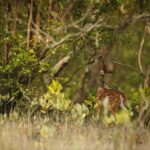Mangrove Forest of Bangladesh: A Natural Wonder of Biodiversity and Resilience

The Mangrove Forest of Bangladesh is most notably represented by the Sundarbans, is one of the most extraordinary and ecologically significant landscapes in the world. Spanning the coastal southern region of Bangladesh and part of eastern India, the Sundarbans is the largest mangrove forest on Earth, covering approximately 10,000 square kilometers. Around 60% of this unique forest lies within Bangladesh’s borders.
Designated as a UNESCO World Heritage Site, the Sundarbans is not just a biological treasure trove but also a crucial shield protecting the country from the destructive forces of tropical cyclones, tidal surges, and coastal erosion. This forest plays a pivotal role in the ecology, economy, and culture of Bangladesh.
What Makes The Mangrove Forest of Bangladesh is Unique?
The Sundarbans is composed of a complex network of tidal waterways, mudflats, and small islands, with dense forests of salt-tolerant mangrove trees. This exceptional environment thrives in the brackish water of the Ganges, Brahmaputra, and Meghna river deltas, creating a perfect habitat for a wide range of species adapted to the intertidal zone.
Among the key features that make this mangrove forest stand out are:
- High salinity tolerance The Mangrove Forest of Bangladesh: The mangrove vegetation has adapted to survive in saline waters, making them unique among tropical forests.
- Dynamic tidal flows: Twice-daily tides reshape the land and water channels on the other hand promoting constant ecological change and nutrient cycling.
- Diverse flora and fauna: The forest is home to over 334 plant species, 270 bird species, 120 fish species, and numerous mammals, reptiles, and invertebrates.
Biodiversity of the Sundarbans The Mangrove Forest of Bangladesh

The Mangrove Forest of Bangladesh supports an incredible range of wildlife, many of which are endangered or threatened. Chief among these is the Royal Bengal Tiger, a symbol of national pride and a vital part of the forest ecosystem. The Sundarbans is the largest habitat of this elusive and majestic animal.
Other notable species include:
-
Saltwater crocodiles (Crocodylus porosus)
-
Spotted deer (Axis axis)
-
Fishing cats (Prionailurus viverrinus)
-
Gangetic dolphins (Platanista gangetica)
-
Various species of kingfishers, herons, and eagles
The forest’s extensive root systems provide breeding grounds for fish and crustaceans, making it essential to the fisheries sector of Bangladesh.
Environmental Importance
The Mangrove Forest of Bangladesh plays a vital role in climate regulation, carbon sequestration, and coastal protection. Its dense roots hold the soil together, preventing erosion and absorbing the energy of storm surges. During devastating cyclones like Sidr and Aila, the Sundarbans acted as a natural barrier, reducing the impact on inland areas.
The Mangroves forest of Bangladesh are also among the most efficient carbon sinks, helping mitigate climate change by storing large amounts of carbon in both biomass and soil.
Economic and Cultural Significance
The local population, many of whom live in vulnerable coastal communities, depend heavily on the Sundarbans for their livelihood for instance The forest provides:
-
Wood and honey collection
-
Fishing and crab harvesting
-
Ecotourism opportunities
Culturally, the forest holds immense importance. Folk traditions, songs, and festivals reflect the deep bond between the people and this natural wonder. Religious beliefs, especially among Hindus and indigenous communities, often regard parts of the Sundarbans as sacred.
Threats to The Mangrove Forest of Bangladesh
Despite its significance, the mangrove forest is under constant threat from natural and human-induced factors:
-
Climate change and sea level rise
-
Illegal logging and over-exploitation of resources
-
Industrial pollution also oil spills
-
Shrimp farming leading to deforestation
-
Invasive species and habitat loss
These threats have resulted in biodiversity loss, forest degradation, furthermore increased vulnerability of coastal communities to climate disasters.
Conservation Efforts and Sustainable Solutions Mangrove Forest of Bangladesh
The Mangrove Forest of Bangladesh is Recognizing the importance of the Sundarbans, both the Bangladeshi government and international organizations have taken steps to protect and preserve the mangrove forest. Some key initiatives include:
-
Declaring protected areas such as wildlife sanctuaries (e.g., Katka, Hiron Point, and Dublar Char)
-
Reforestation and afforestation programs in degraded mangrove areas
-
Community-based conservation in addition awareness campaigns
-
Sustainable tourism policies to balance ecological impact as a result economic benefit
-
Climate adaptation projects there fore supported by global agencies like the World Bank and UNDP
Conclusion
The mangrove forest of Bangladesh and especially the iconic Sundarbans, is a natural marvel that stands at the intersection of biodiversity, culture, moreover climate resilience. The mangrove forest of Bangladesh Protecting this invaluable ecosystem is not just a national priority—it is a global imperative. Through collaborative conservation, sustainable resource management, and climate action, the mangrove forest can continue to thrive and serve as a living legacy for generations to come.
Would you like a version of this article formatted for a blog (e.g., with headings in Markdown or HTML)?
